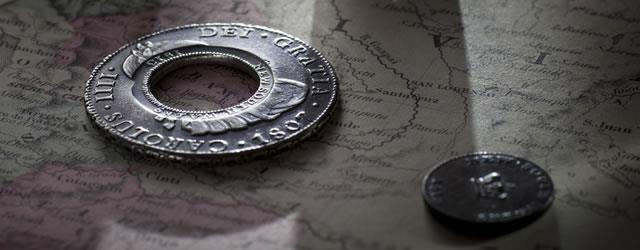In 1812 the Governor set in motion a plan to resolve the colonys currency crisis by importing 40,000 Spanish Silver Dollars.
To stop the coins disappearing into traders pockets, he had them punched-out and re-stamped, making them useless outside Australia. In the process, each dollar became two coins: the large donut-like outer ring, and the punched-out inner disc.
The newly created ring was re-stamped with a value of five shillings, the year 1813, and had the issuing authority of New South Wales around the inner circumference. This became the 1813 Holey Dollar.
The circular inner was re-stamped with a crown, the year 1813, the issuing authority and the value of fifteen pence. This became the Colonial Dump.
The coins provided a vital short-term solution to the colonys currency crisis and remained in official circulation for 16 years, before being withdrawn in 1829 when the Sterling standard was re-imposed.
Of the 40,000 Spanish Dollars imported by Governor Lachlan Macquarie, 39,910 Holey Dollars and 39,910 Colonial Dumps were released into circulation; the balance assumed spoiled during the striking.
Withdrawn from circulation in 1826, a total of 27,161 Holey Dollars and 10,103 Dumps were shipped to London and melted down, sold off as bullion silver. Of those that didnt go to the smelter, there are now only some 300 known surviving Holey Dollars (around 200 of them in private hands) and about 800 Dumps.
The combination of their rarity and their fascinating history makes them two of the worlds most famous and sought after coins.




